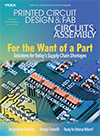TR5001 SII Tiny ICT is compact and portable. Offers up to 640 testing points; extends coverage with boundary scan. Desktop footprint offers parallel testing using multiple USB-connected units, audio analyzer and data acquisition modules, and programmable power supplies for testing devices and LED strips.
TRI, www.tri.com.tw
Cog-Watch predictive analytics tool anticipates critical risks within the electronics supply chain. Tracks supply and demand risks in production lifecycles, and alerts to shortages and overstocking. Predictive algorithm analyzes historical data of an ERP system with that of distributor market data to determine the critical risk level of all individual components.
Precogs, www.precogs.com
Custom Gripper Nozzles for Panasonic CM and NPM machines have multifunction placement heads. Feature vacuum-actuated jaws for gripping parts and shapes that cannot be placed with traditional SMT placement tools. Pick components from tape, trays and other feeding solutions. Are guaranteed to function properly with original equipment.
Count On Tools, www.cotinc.com
KISS-105 is capable of inline selective soldering of printed circuit boards up to 28" x 36". Reportedly can handle the size and weight of large backplanes and other oversized products. When equipped with a topside preheater, it can achieve Class 3 solder joints on printed circuit boards with a thickness of up to 0.354". Large boards are processed in a 1" border frame that supports, locates and flattens the board. Frame mounted boards are conveyed into the system in a SMEMA manner where they are optically aligned, located and camped into position. After flux application, preheating elevates the topside board temperature to a set temperature and maintains the temperature throughout the soldering cycle. PCB remains stationary. Is equipped with “Super Quick” motion and closed-loop positioning feedback with linear encoders. Has offline programming software. Features include program-controlled conveyor width adjustment, positive PCB locating and flattening, fiducial alignment and skew correction.
ACE Production Technologies, www.ace-protech.com
Buzzard camera and illumination system for optical inspection of selective solder joints to be integrated into external test cells. Contains 4Mp camera with GigE interface, multispectral illumination, PC and software. Can be configured to optical test demands of each inspection system. Camera provides functionalities for image pre-processing. Multispectral illumination includes control, coverage of light spectrum from UV to IR, and high-contrast images of inspected solder joints and components. Includes TOM Line software for industrial applications; features a range of test functions, for example to evaluate plated through-hole solder joints, shorts or solder splashes. Software can be operated by a remote interface.
Goepel electronic, www.goepel.com
XT-657 flame retardant bonding tape helps prevent the propagation of fire, provides dielectric separation between electrical circuits, and eliminates mechanical fasteners in battery assemblies and packs. Halogen-free UL94 VTM-0 tested tape provides a thin conformal bond line and offers an adhesive strength of greater than 32 oz/in (>35N/100 mm). Is used to attach batteries and components to chassis, boards, other batteries, etc. Is REACH and RoHS compliant; includes a 25µm polyimide film, two layers of 1 mil acrylic pressure sensitive adhesive and liners that aid in handling, die cutting and auto application. Has dielectric strength of >7.6 kV/mil (>299kV/mm).
Polyonics, www.polyonics.com



